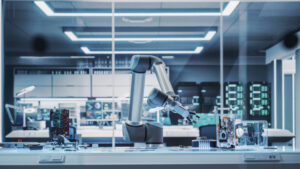Written by Scott Wilson

When it began, the internet was a purely virtual world. Information flicking through electrical impulses, traveling down unseen wires, and coming to us only through the ghostly light of computer monitors.
As long as the internet depended on wires and expensive computer chips to connect, that’s all it could be. But it all changed when radio-based protocols like WiFi were developed and when powerful computing devices could be shrunk down small enough to fit in our pockets.
The Internet of Things is a network of smart devices incorporating sensors, software, and communication technology to connect to other devices or remote servers. Everything from thermostats to lightbulbs can be:
- Controlled by apps remotely
- Coordinate their status and activities automatically
- Offer instantaneous monitoring and alerts
Many of those smart devices are about to get much smarter. Now, we’re entering an era of AIoT: The Artificial Intelligence of Things.


How the Internet Has Extended Itself to Every Corner of Modern Life
 The Internet of Things has been a thing since microprocessors became fast enough and cheap enough to routinely embed in ordinary household appliances and tools. At roughly the same time, around 2008, internet penetration and particularly wireless internet became ubiquitous enough to connect all those devices to other systems and applications to make them useful.
The Internet of Things has been a thing since microprocessors became fast enough and cheap enough to routinely embed in ordinary household appliances and tools. At roughly the same time, around 2008, internet penetration and particularly wireless internet became ubiquitous enough to connect all those devices to other systems and applications to make them useful.
The potential for widespread connectivity and monitoring took off like a rocket. From doorbells that show video and audio of your front porch to lightbulbs that can change color and hue at the tap of an app, IoT devices are everywhere. According to IoT Analytics’ Spring 2023 report, the number of connected devices on the internet in 2022 grew by 18 percent.
That comes to over 14 billion active IoT connections around the world. And the number continues to grow.
Before Your Coffee Machine Was Online, Coke Was There First
 Although it wouldn’t become practical for decades afterward, people began to dream of the internet of things almost as soon as the internet lit up.
Although it wouldn’t become practical for decades afterward, people began to dream of the internet of things almost as soon as the internet lit up.
In 1982, lazy or ambitious grad students at Carnegie Mellon’s computer science department got tired of going up and down stairs to buy a soda at the department vending machine only to find it empty… or, nearly as bad, recently reloaded and therefore dispensing only warm bottles.
Making use of the building network and computational systems, they wired up microswitches in the machine to monitor which columns were empty and when they were refilled. From that, they could also calculate how likely the soda was to have become sufficiently chilled.
At first, only users with access to the local PDP mainframe could see the machine’s status. But some enterprising student eventually configured the program to use the common Unix application finger. Since CMU was one of the early sites on the experimental ARPANET, anyone else on the net could just type “finger coke@cmua” and learn if you could get a cold Coke at CMU CompSci.
It was the first IoT device on the internet… and the internet hadn’t even technically been created yet.
Where the Internet of Things Is Most Important Today
IoT tech powers smart homes, office buildings, hospitals, and factories today. You can find smart devices on people’s wrists in the form of smart watches, and lurking in the background as speakers that can respond to any query and control any other smart device in a house.
But home applications are just the tip of the iceberg. IoT is taking off because it offers some real cost and time-saving solutions to business, as well.
- Commercial - Enterprise IoT helps run office buildings, keep tabs on hospital patients, and allow vehicles to report back maintenance information and breakdowns.
- Industrial - In major factories, smart devices track products, monitor production processes, and help manage electrical use. Even outside, as used in big agriculture, smart devices play a role in monitoring crop and soil health, looking for pest infestations, and providing up-to-the-second weather data.
- Infrastructure - Traffic monitoring and bridge structural health are among the infrastructure-related uses for IoT devices, taking smart management up to the metropolitan level. Everything from sewer systems to energy grids are being optimized with smart devices.
Why IoT Needs a Helping Hand From AI
While the internet of things has become enormously useful and even commonplace in some parts of the world, it has also created problems:
- Complexity - Many new devices create a more complicated information environment. As the old saying goes, a person with a watch always knows what time it is; someone with two watches is never sure. Conflicting or ambiguous readings require more investigation and decision-making to address. And devices can create unexpected problems with one another, creating unforeseen feedback loops through conflicting actions.
- Congestion - The original design for the internet envisioned a world in which no more than around 4 billion machines would be connected at once. As we’ve seen, IoT devices alone already blow the lid off that by more than 10 billion units. Network congestion and routing become a challenge with so much traffic circulating.
- Standards - With so many manufacturers deploying IoT devices, not all of them are on the same page. Some may report data in metric, others use imperial. Some have a fine-grained location reporting resolution down to centimeters, while others may report their grid measured in meters. And while some may communicate directly, others are locked in proprietary protocols that don’t work with others at all.
- Updates - Everyone today is familiar with the concept of software patches; your phone gets them all the time. IoT devices need them to, for security and new features—but so many organizations make such devices that many are left behind. Either abandoned or outmoded, they represent obstacles in the network rather than useful tools.
Intelligence, and particularly artificial intelligence, is the secret sauce that can allow the internet and the things themselves to cope with all these various mismatches and challenges.
How the Artificial Intelligence Internet of Things Will Power Lifestyles and Industry
 Artificial intelligence is poised to take all of these areas of IoT use to the next level. As smart as smart devices can be, they remain limited today in various ways.
Artificial intelligence is poised to take all of these areas of IoT use to the next level. As smart as smart devices can be, they remain limited today in various ways.
Artificial intelligence can remove those limitations and bring new capabilities to IoT devices. Maybe just as importantly, it can help overcome some of the many challenges that have been uncovered in the Internet of Things itself.
For example, AI-powered IoT devices can help overcome standards problems by having more flexible ways of communicating with one another. Rather than rigidly defined handshake and data exchange protocols, AI may be able to get the drift of what other devices are saying by inference and observation… like a New York City cabbie getting directions from Norwegian tourist.
And the complexity and congestion of the network can be dealt with better out at the edges and without human intervention if AI is baked into smart devices.
Using AI to Deal with the Big Data Stream From the IoT
One of the most important capabilities that AI may bring to the IoT is a native ability to digest and make use of all the vast oceans of data that those devices generate.
Today, to the extent that IoT data is useful, it’s because it’s collated on remote servers and processed, or viewed directly by humans and acted on piecemeal.
That means that only a fraction of the information collected is actually or immediately useful. It has also created a lot of Balkanization in the field. Different companies don’t release their data consistently, or allow other devices to use it.
AI systems can make use of information without human intervention or a round trip to a server farm somewhere. In fact, IoT devices may become much better at interacting with one another directly. Using common protocols and essential reasoning skills, they may collaborate for a better overall application of the information they uncover.
AI Can Provide Better Security in Devices Intimately Engaged With Our Daily Lives
 One of the biggest drawbacks of the IoT has proven to be security. It turns out that having a smart refrigerator isn’t so smart when hackers can penetrate it and use it to send out spam.
One of the biggest drawbacks of the IoT has proven to be security. It turns out that having a smart refrigerator isn’t so smart when hackers can penetrate it and use it to send out spam.
AI can help harden IoT devices against such attacks. While complacency and laziness are behind a lot of vulnerabilities, the challenge of keeping so many devices updated constantly against every new issue is huge.
Dynamic AI-based security protocols can help with that by including defenses that are more based on reasoning than on specific code vulnerabilities. A smart cybersecurity system powered by AI can resist attacks it has never seen before by analyzing them and applying basic logic.
How AI’s Entry to the Home Will Come through the IoT
One of the first applications of AI in IoT has been in the smart home. It’s also probably the first exposure that most people will have to AI.
Companies like Google and Amazon are leading the charge in incorporating AI into their disembodied personal assistants.
At first, AI was used to tune the natural language capabilities of those devices. It made them better at understanding requests and more fluent in delivering replies.
This alone was a transformative boost in their abilities. But now AI is also being used to improve the reasoning and understanding these devices have of the meaning behind such conversations. Smart personal assistants can infer context and offer relevant actions; they may help draft messages, automatically adjust lighting and environmental systems, or find just the right song to match your mood… all without explicit direction.
What Does the Future Hold for AI and the Internet of Things?
 The Internet of Things hasn’t been around very long yet. AI is still very early in its own innovation cycle. So it’s fair to say that we probably haven’t yet even been able to imagine some of the most impressive abilities that combining the two technologies will bring.
The Internet of Things hasn’t been around very long yet. AI is still very early in its own innovation cycle. So it’s fair to say that we probably haven’t yet even been able to imagine some of the most impressive abilities that combining the two technologies will bring.
No one should overlook the ability of AI to also offer a boost at simply helping IoT devices and systems get better at what they are originally designed for. Google, a leader in AI development, has already gotten more bang for its buck in data center temperature monitoring and HVAC controls by dropping machine learning routines onto them.
Of course, AI will also bring other unknowns into the IoT that aren’t so beneficial. We already know that the state of machine learning today has some significant limitations. Hallucinations, baked-in biases, and an inability to understand how exactly it comes to decisions are all serious limitations in every application of artificial intelligence.
They will pose challenges for AI uses in the Internet of Things as well.
New and Weird Ways for the Internet of Things to Go Wrong With AI
 When you combine serious glitches like AI hallucinations with millions of remotely distributed, difficult-to-update devices scattered around the world, you have a recipe for some real problems. A smart home that learns over time exactly how to optimize the temperature and lighting for you and your family will offer big energy savings and a more comfortable home environment.
When you combine serious glitches like AI hallucinations with millions of remotely distributed, difficult-to-update devices scattered around the world, you have a recipe for some real problems. A smart home that learns over time exactly how to optimize the temperature and lighting for you and your family will offer big energy savings and a more comfortable home environment.
Now imagine that the machine learning algorithm instead learns that your cat is the primary resident. After all, it’s around the place more often. Up at 3am, napping through the middle of the day, and cozy with a built-in fur coat, you can imagine that suddenly the place would be a lot less comfortable for people!
Smarter systems can make life easier for everyone—or they can make the complications much worse.
While AI brings with it the potential to greatly smooth out interactions between IoT systems, that’s not an inevitable outcome. Manufacturers could also choose to use AI to make it even harder for competing systems to work with their devices. This could even go so far as introducing malicious misinformation or attempting to disable competing devices in the IoT.
Privacy Concerns Are Compounded by AI Use in the Internet of Things
 Many people are already a little nervous about the broad use of video and audio monitors quickly spreading out through American neighborhoods. Chances are, your walk down a quaint and quiet suburban street is already about as well documented on various doorbell cams as if you were on the set of a big Hollywood blockbuster.
Many people are already a little nervous about the broad use of video and audio monitors quickly spreading out through American neighborhoods. Chances are, your walk down a quaint and quiet suburban street is already about as well documented on various doorbell cams as if you were on the set of a big Hollywood blockbuster.
Now imagine if all those cams were talking to one another… and to facial recognition databases, phone location data, cash machines, and credit card processing systems.
AI in the IoT puts privacy concerns about widespread tracking and personal data on steroids.
All of a sudden, the warm and cuddly Internet of Things starts to look an awful lot like Big Brother.
AI engineers will have to work with privacy experts and ethics professionals as well as government regulators to keep the blend of AI and IoT from turning into a dystopian nightmare.
The potential is too great for their efforts to fail, however. Building AI into the IoT is a step toward the future that people most want: one where artificial intelligence smoothies out all the little things and makes life better on a daily basis.
What Is the Best Degree for AI in IoT?
 The internet of things exists at the intersection of hardware and software. This is a natural fit for anyone who has earned a degree like a Master’s in Robotics and Autonomous Systems, or a Master of Science in Artificial Intelligence concentration in Robotics and Automation.
The internet of things exists at the intersection of hardware and software. This is a natural fit for anyone who has earned a degree like a Master’s in Robotics and Autonomous Systems, or a Master of Science in Artificial Intelligence concentration in Robotics and Automation.
Of course, any kind of AI or machine learning degree will lay the groundwork for IoT programming. But the particular concerns of coding for systems that interact with the real-world can be tough to pick up after college. A Graduate Certificate in Autonomous Systems can help build out that skillset, however. There are even Internet of Things Graduate Certificate programs available at select universities.
Taking only a few months as opposed to two or more years, a certificate
- Digital Communication
- Autonomous Implantable Systems
- Biochips
- Sensor Systems
- Nanoelectromechanical Systems
Experts who tie those fields together with AI and ML will be first on the list of organizations hiring to build out their IoT networks.





